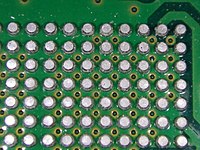
Photo from wikipedia
Abstract The nodal connection system for the free-form grid spatial structures should both implement complex-shaped curvature and fulfil the required loading capacity, whilst also meeting various important requirements, such as… Click to show full abstract
Abstract The nodal connection system for the free-form grid spatial structures should both implement complex-shaped curvature and fulfil the required loading capacity, whilst also meeting various important requirements, such as quick and easy assembly at the construction site. A novel joint system named gear joint with the above advantages, developed for free-form grid spatial structures, is presented in this paper. First, a series of tests was carried out considering different bolt diameters, tooth heights, tooth numbers and ball thicknesses. The different failure modes and whole moment-rotation (M-Ф) curves of gear bolt joints were obtained, and the joint stiffness and strength were investigated. Second, a three-dimensional finite element (FE) model of the joint was established. The comparison between computation and experiments highlights the degree of accuracy of the proposed FE model. The stiffnesses, strengths, rotation behaviours, and failure modes of the new joint system were carefully compared and discussed. Based on the results, the influence rules of the parameters on the mechanical behaviour of the new joint were obtained. Finally, based on the power-function model, the formulae for predicting the M-Ф curves of the joints were established. The M-Ф curves have preferable accuracy compared with the experimental curves.
Journal Title: Engineering Structures
Year Published: 2017
Link to full text (if available)
Share on Social Media: Sign Up to like & get
recommendations!